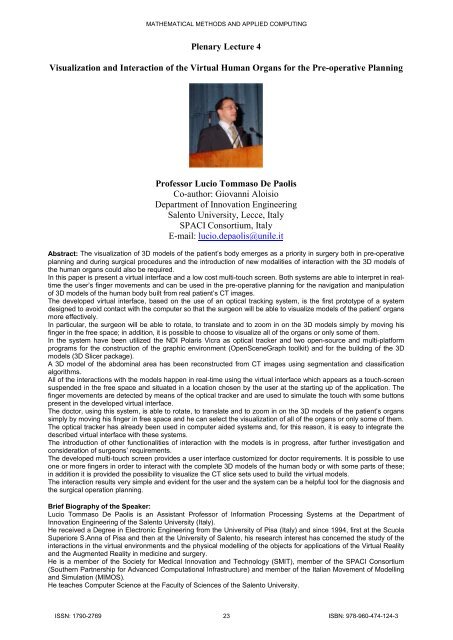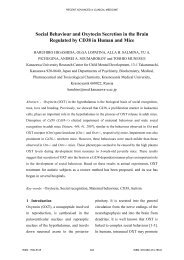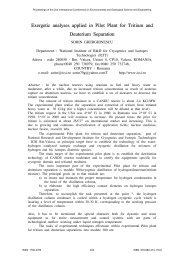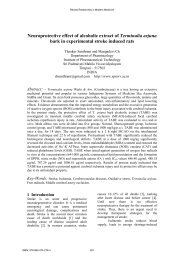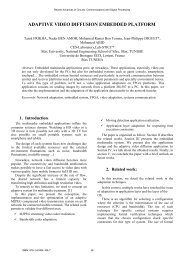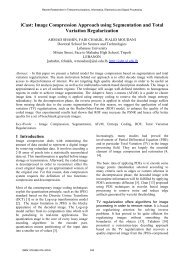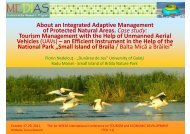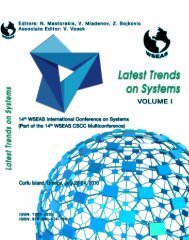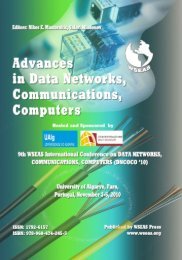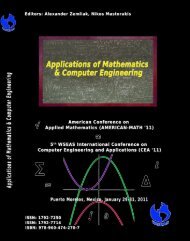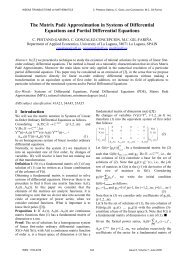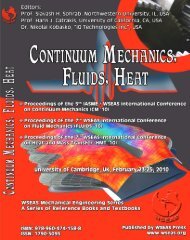Mathematical methods and - Wseas.us
Mathematical methods and - Wseas.us
Mathematical methods and - Wseas.us
Create successful ePaper yourself
Turn your PDF publications into a flip-book with our unique Google optimized e-Paper software.
MATHEMATICAL METHODS AND APPLIED COMPUTINGPlenary Lecture 4Visualization <strong>and</strong> Interaction of the Virtual Human Organs for the Pre-operative PlanningProfessor Lucio Tommaso De PaolisCo-author: Giovanni AloisioDepartment of Innovation EngineeringSalento University, Lecce, ItalySPACI Consortium, ItalyE-mail: lucio.depaolis@unile.itAbstract: The visualization of 3D models of the patient’s body emerges as a priority in surgery both in pre-operativeplanning <strong>and</strong> during surgical procedures <strong>and</strong> the introduction of new modalities of interaction with the 3D models ofthe human organs could also be required.In this paper is present a virtual interface <strong>and</strong> a low cost multi-touch screen. Both systems are able to interpret in realtimethe <strong>us</strong>er’s finger movements <strong>and</strong> can be <strong>us</strong>ed in the pre-operative planning for the navigation <strong>and</strong> manipulationof 3D models of the human body built from real patient’s CT images.The developed virtual interface, based on the <strong>us</strong>e of an optical tracking system, is the first prototype of a systemdesigned to avoid contact with the computer so that the surgeon will be able to visualize models of the patient’ organsmore effectively.In particular, the surgeon will be able to rotate, to translate <strong>and</strong> to zoom in on the 3D models simply by moving hisfinger in the free space; in addition, it is possible to choose to visualize all of the organs or only some of them.In the system have been utilized the NDI Polaris Vicra as optical tracker <strong>and</strong> two open-source <strong>and</strong> multi-platformprograms for the construction of the graphic environment (OpenSceneGraph toolkit) <strong>and</strong> for the building of the 3Dmodels (3D Slicer package).A 3D model of the abdominal area has been reconstructed from CT images <strong>us</strong>ing segmentation <strong>and</strong> classificationalgorithms.All of the interactions with the models happen in real-time <strong>us</strong>ing the virtual interface which appears as a touch-screens<strong>us</strong>pended in the free space <strong>and</strong> situated in a location chosen by the <strong>us</strong>er at the starting up of the application. Thefinger movements are detected by means of the optical tracker <strong>and</strong> are <strong>us</strong>ed to simulate the touch with some buttonspresent in the developed virtual interface.The doctor, <strong>us</strong>ing this system, is able to rotate, to translate <strong>and</strong> to zoom in on the 3D models of the patient’s organssimply by moving his finger in free space <strong>and</strong> he can select the visualization of all of the organs or only some of them.The optical tracker has already been <strong>us</strong>ed in computer aided systems <strong>and</strong>, for this reason, it is easy to integrate thedescribed virtual interface with these systems.The introduction of other functionalities of interaction with the models is in progress, after further investigation <strong>and</strong>consideration of surgeons’ requirements.The developed multi-touch screen provides a <strong>us</strong>er interface c<strong>us</strong>tomized for doctor requirements. It is possible to <strong>us</strong>eone or more fingers in order to interact with the complete 3D models of the human body or with some parts of these;in addition it is provided the possibility to visualize the CT slice sets <strong>us</strong>ed to build the virtual models.The interaction results very simple <strong>and</strong> evident for the <strong>us</strong>er <strong>and</strong> the system can be a helpful tool for the diagnosis <strong>and</strong>the surgical operation planning.Brief Biography of the Speaker:Lucio Tommaso De Paolis is an Assistant Professor of Information Processing Systems at the Department ofInnovation Engineering of the Salento University (Italy).He received a Degree in Electronic Engineering from the University of Pisa (Italy) <strong>and</strong> since 1994, first at the ScuolaSuperiore S.Anna of Pisa <strong>and</strong> then at the University of Salento, his research interest has concerned the study of theinteractions in the virtual environments <strong>and</strong> the physical modelling of the objects for applications of the Virtual Reality<strong>and</strong> the Augmented Reality in medicine <strong>and</strong> surgery.He is a member of the Society for Medical Innovation <strong>and</strong> Technology (SMIT), member of the SPACI Consortium(Southern Partnership for Advanced Computational Infrastructure) <strong>and</strong> member of the Italian Movement of Modelling<strong>and</strong> Simulation (MIMOS).He teaches Computer Science at the Faculty of Sciences of the Salento University.ISSN: 1790-2769 23 ISBN: 978-960-474-124-3


